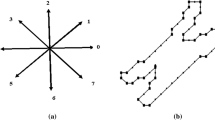Abstract
In this paper we propose a new algorithm for extracting dominant points from the real contour of a digital shape. A polygonal approximation of the shape can be obtained by the set of dominant points. In the proposed algorithm, in the first step before searching for dominant points, the real contour is made sparse using a geometric concept, named convex deficiency tree. This helps to select a set of candidate points from real contour. In comparison with break points (which are initial points in many algorithms), the set of candidate points is more heuristic and the ratio of them to the all points of the contour is lower. In the second step of the proposed algorithm, the less informative candidate points are removed in an iterative manner. After removing one candidate point, its adjacent positions are searched to find more stable position for its neighbors. The comparative result of the proposed algorithm with others shows its efficiency. The algorithm finds an effective polygonal approximation for digital shapes especially for the real contours, which makes the method more practical.









Similar content being viewed by others
References
Ruberto DC, Morgera A (2009) A new iterative approach for dominant points extraction in planar curves Source. WSEAS Trans Comput 8(3):482–493
Wu WY (2003) An adaptive method for detecting dominant points. Pattern Recognit 36:2231–2237
Attneave F (1954) Some informational aspects of visual perception. Psychol Rev 61:189–193
Masood A, Haq SA (2007) A novel approach to polygonal approximation of digital curves. J Vis Commun Image Represent 18:264–274
Hsin-Teng S, Wu-Chih H (1996) A rotationally invariant two-phase scheme for corner detection. Pattern Recognit 29:819–828
Melkman A, O’Rourke J (1998) On polygonal chain approximation. In: Toussaint GT (ed) Computational morphology. North-Holland, Amsterdam, pp 87–95
Perez JC, Vidal E (1994) Optimum polygonal approximation of digitized curves. Pattern Recognit Lett 15:743–750
Pikaz A, Dinstein I (1995) Optimal polygonal approximation of digital curves. Pattern Recognit 28:373–379
Salotti M (2001) An efficient algorithm for the optimal polygonal approximation of digitized curves. Pattern Recognit Lett 22:215–221
Teh CH, Chin RT (1989) On the detection of dominant points on digital curves. IEEE Trans Pattern Anal Mach Intell 11:859–872
Ansari N, Huang KW (1991) Non-parametric dominant points detection. Pattern Recognit 24:849–862
Ray BK, Ray KS (1992) Detection of significant points and polygonal approximation of digitized curves. Pattern Recognit Lett 22:443–452
Ray BK, Ray KS (1992) An algorithm for detecting dominant points and polygonal approximation of digitized curves. Pattern Recognit Lett 13:849–856
Zhu P, Chirlian PM (1995) On critical point detection of digital shapes. IEEE Trans Pattern Anal Mach Intell 17(8):737–748
Marji M, Siy P (2003) A new algorithm for dominant point detection and polygonization of digital curves. Pattern Recognit 36:2239–2251
Wu WY (2003) Dominant point detection using adaptive bending value. Image Vis Comput 21:517–525
Marji M, Siy P (2004) Polygonal representation of digital planar curves through dominant point detection—a nonparametric algorithm. Pattern Recognit 37:2113–2130
Carmona-Poyato A, Fernandez-Garcia NL, Medina-Carnicer R, Madrid-Cuevas FJ (2005) Dominant point detection: a new proposal. Image Vis Comput 23:1226–1236
Masood A (2008) Dominant point deletion by reverse polygonization of digital curves. Image Vis Comput 26:702–715
Masood A (2008) Optimized polygonal approximation by dominant point deletion. Pattern Recognit 41:227–239
Garrido A, Perez N, Garcia-Silvente M (1998) Boundary simplification using a multiscale dominant-point detection algorithm. Pattern Recognit 31:791–804
Ray BK, Pandyan R (2003) ACORD—an adaptive corner detector for planar curves. Pattern Recognit 36:703–708
Canny J (1986) A computational approach to edge detection. IEEE Trans Pattern Anal Mach Intell PAMI-8(6):679–698
Freeman H (1961) On the encoding of arbitrary geometric configurations. IEEE Trans Electron Comput 10:260–268
Wu L (1982) On the chain code of a line. IEEE Trans Pattern Anal Mach Intell 4:347–353
Sarkar D (1993) A simple algorithm for detection of significant vertices for polygonal approximation of chain-coded curves. Pattern Recognit Lett 14:959–964
Rosin PL (1997) Techniques for assessing polygonal approximation of curves. IEEE Trans Pattern Anal Mach Intell 19(6):659–666
Batchelor BG (1980) Hierarchical shape description based upon convex hulls of concavities. J Cybern 10:205–210
Carmona-Poyato A, Madrid-Cuevas FJ, Medina Carnicer R, Munoz-Salinas R (2010) Polygonal approximation of digital planar curves through break point suppression. Pattern Recognit 43(1):14–25
Carmona-Poyato A, Medina-Carnicer R, Muñoz-Salinas R, Yeguas-Bolivar E (2012) On stop conditions about methods to obtain polygonal approximations relied on breakpoint suppression. Image Vis Comput 30(8):513–523
Hao S, Jiang J, Guo Y, Zhan S (2012) ϵ-Isometry based shape approximation for image content representation. Signal Process (in press)
Latecki LJ, Lakamper R (1999) Convexity rule for shape decomposition based on discrete contour evolution. Comput Vis Image Underst 73:441–454
Cronin TM (1999) A boundary concavity code to support dominant points detection. Pattern Recognit Lett 20:617–634
Dobkin D, Guibas L, Hershberger J, Snoeyink J (1988) An efficient algorithm for finding the CSG representation of a simple polygon. Comput Graph 22(4):31–40
Shapiro V (2001) A convex deficiency tree algorithm for curved polygons. Int J Comput Geom Appl 11(2):215–238
Parvez MT, Mahmoud SA (2010) Polygonal approximation of digital planar curves through adaptive optimizations. Pattern Recognit Lett 31:1997–2005
Nguyen TP, Rennesson ID (2011) A discrete geometry approach for dominant point detection. Pattern Recognit 44:32–44
Acknowledgments
We want to thank A. A. Carmona-Poyato for kindly providing us the results of his method via mail to be compared with our proposed method.
Author information
Authors and Affiliations
Corresponding author
Rights and permissions
About this article
Cite this article
Tahaei, M.S., Hashemi, S.N., Mohades, A. et al. Geometric algorithm for dominant point extraction from shape contour. Pattern Anal Applic 17, 481–496 (2014). https://doi.org/10.1007/s10044-012-0311-9
Received:
Accepted:
Published:
Issue Date:
DOI: https://doi.org/10.1007/s10044-012-0311-9




